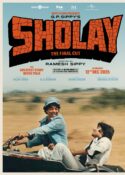Note: The views expressed in this article do not reflect the views of BollySpice.com’s staff or owners. They are solely the views of the writer of this opinion piece/blog.
 This past Friday saw the release of Sanjay Sharma’s attempt at portraying homosexual relationships in a serious fashion with his film Dunno Y Na Jaane Kyun and this has prompted a very strong and emotional thought process within me, one that has been simmering for many years. Homosexuality is taboo in the Indian culture, yet it has been embraced as a subject and main plot line in many Indian films; although this is something we must celebrate, we must also sit back and look at the way in which this subject is being portrayed and the consequences it may have. Since the early 2000’s we are seeing more prominent homosexual characters and subjects enter Indian cinema. There have been a slew of films that have dealt with the issue in a more serious manner, Onir’s My Brother Nikhil being a prominent example and even the realistic portrayal of homosexual relationships in modern Indian society in Madhur Bhandarkar’s Fashion – despite the deleted gay kissing scene.
This past Friday saw the release of Sanjay Sharma’s attempt at portraying homosexual relationships in a serious fashion with his film Dunno Y Na Jaane Kyun and this has prompted a very strong and emotional thought process within me, one that has been simmering for many years. Homosexuality is taboo in the Indian culture, yet it has been embraced as a subject and main plot line in many Indian films; although this is something we must celebrate, we must also sit back and look at the way in which this subject is being portrayed and the consequences it may have. Since the early 2000’s we are seeing more prominent homosexual characters and subjects enter Indian cinema. There have been a slew of films that have dealt with the issue in a more serious manner, Onir’s My Brother Nikhil being a prominent example and even the realistic portrayal of homosexual relationships in modern Indian society in Madhur Bhandarkar’s Fashion – despite the deleted gay kissing scene.
However, for the most part those that appear in Bollywood films, mainstream Hindi cinema, do not necessarily present homosexuality in a positive light. What is it about homosexuality that becomes so fascinating for Indian storytellers and why is there a need to only portray homosexuality through comedy in mainstream cinema? As a South Asian gay man myself, it is deeply offending for me to see homosexuality portrayed in a comedic fashion. I have nothing against comedic representations of homosexuality, but there is something about recent Bollywood representations that have my mind buzzing. While I have not seen Dunno Y Na Jaane Kyun and I certainly plan to, past Bollywood blockbusters have only made me cringe.
While my parents were born in the Fiji Islands, my ancestry is from India. Today I speak Hindi, watch Bollywood films and celebrate my religion and cultural festivities with family and friends. However, being born and raised in Canada has given me a different perspective about homosexuality and its treatment in mainstream Hindi cinema. Now, while I am a gay man, I truly believe that what I discuss here is significant when we sit back and really look into the issues at play and their repercussions once we walk out of the theatre.
 This article focuses on two films produced and directed under director Karan Johar’s banner, Dharma Productions: Kal Ho Naa Ho (Tomorrow May Never Come) and Dostana (Friendship). Both films portray Indian protagonists who engage in and are surrounded by situations involving homosexuality, with plots in foreign settings.
This article focuses on two films produced and directed under director Karan Johar’s banner, Dharma Productions: Kal Ho Naa Ho (Tomorrow May Never Come) and Dostana (Friendship). Both films portray Indian protagonists who engage in and are surrounded by situations involving homosexuality, with plots in foreign settings.
While Kal Ho Naa Ho and Dostana open up a space to allow homosexuality to exist within the Bollywood narrative, their treatment of homosexuality works only to reinforce Indian cultural ideals and attempts to recreate a sacred/orthodox/mainstream Indian culture. The maidservant in the Kantaben scenes in Kal Ho Na Ho is emblematic of traditional Indian values; therefore, her reactions illustrate an ignorance and un-acceptance of homosexuality. Despite the diasporic and western setting, the maidservant’s continued negative reactions deepen the sense of “rootedness” that the Indian diaspora has of its Indian values and traditions, aspects of Indian culture believed to be lost during the migratory experience. While the comical portrayals of homosexuality between Aman and Rohit are infrequent, limited to a few scenes in Kal Ho Naa Ho, in Dostana, homosexuality is part of the main plot and integral to the relationships and interactions between all the characters. Set in Miami, the film attempts to display homosexuality in a nonchalant fashion, denying any attempt to deal with the serious issues that exist in and outside same-sex desires, just as in Kal Ho Naa Ho. Dostana can be seen as an attempt to place homosexuality strictly within a globalized India.
 These films use these moments of suggestive homosexuality to explore the element of suppressed homosexuality in the Indian culture, but at the same time using these moments to titillate Indian audiences – both at home and in the diaspora. In this sense, Kal Ho Naa Ho and Dostana advocate a return to the roots of a traditional/static Indian culture rather than exploring the transition within the Indian nation. In fact, the Indian nation and culture is ever changing and these examples from Kal Ho Naa Ho and Dostana become even more important. Recently, New Delhi High Court’s decision in July 2009 to decriminalize private consensual sex between same-sex adults and a recent draft law allowing unmarried couples, including unmarried same sex couples to have children through surrogacy, the idea of a homogeneous heterosexual Indian culture has been redefined, both for the people living in India and the South Asian diaspora.
These films use these moments of suggestive homosexuality to explore the element of suppressed homosexuality in the Indian culture, but at the same time using these moments to titillate Indian audiences – both at home and in the diaspora. In this sense, Kal Ho Naa Ho and Dostana advocate a return to the roots of a traditional/static Indian culture rather than exploring the transition within the Indian nation. In fact, the Indian nation and culture is ever changing and these examples from Kal Ho Naa Ho and Dostana become even more important. Recently, New Delhi High Court’s decision in July 2009 to decriminalize private consensual sex between same-sex adults and a recent draft law allowing unmarried couples, including unmarried same sex couples to have children through surrogacy, the idea of a homogeneous heterosexual Indian culture has been redefined, both for the people living in India and the South Asian diaspora.
Through the portrayal of foreign concepts such as homosexuality against a perceived sacred and traditional Indian culture Kal Ho Naa Ho and Dostana become examples of Bollywood cinema that are slowly but surely experimenting with new narratives in an attempt to reclaim authentic Indian values and beliefs. However, what is integral to these representations is the influence these depictions have on the negotiation of an Indian identity for those living outside of India, the diaspora, and how through the viewing process, this community is able to take these representations of homosexuality to either undermine a perceived authentic Indian culture or generate a need to preserve its sacred and traditional nature. I pray for a day when a mainstream blockbuster Bollywood film can portray homosexuality in its reality and how and why it exists the way it does in the Indian culture. Only then do I believe we can view homosexuality as a realistic part of the Indian culture and society.









